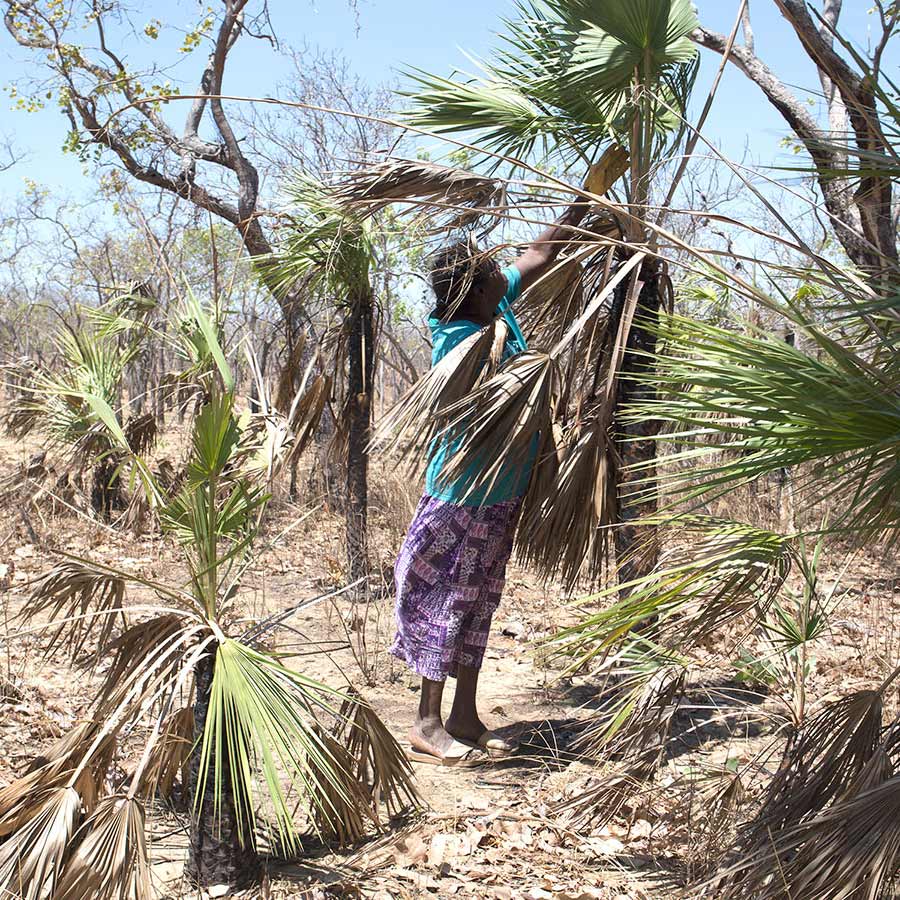The Merrepen Arts Centre
Merrepen Art Centre belongs to the Nauiyu (Daly River) community and was founded in 1986. It is a well established Aboriginal Art Centre situated 230 kms from Darwin. The Centre has a reputation for producing quality paintings, etchings and textiles.
The centre has grown from being a women's centre to an internationally known art centre. Many of the artists have work included in major national and international collections.
The art centre operates with about 130 people dropping in at various times. There is a core group of fifty who are regularly involved. Merrepen artists are now recognized on a national and international level.
Members of the art centre have to be over 18 and live locally. Artworks created for the centre are made available for sale to the public through the art centre gallery. The artists receive money from the sale of all the goods sold in the gallery.
In 2021 some of the artists who produce textiles will exhibit at the prestigious Fowler Museum in Los Angeles.
The distinctive style of Merrepen artists is different to what is generally expected of Aboriginal art. It has been influenced by the location of the community in the tropics: landscape, colour, light in the area that is next to the Daly River. Many of the designs draws inspiration from the wetlands, plants and animals of this region.
Merrepen Arts is owned by the Nauiyu Community and is administered by a Board of Directors (ICN 115). CATSI Act 2006.
Merrepen Arts receives federal funding through IVAIS.




Merrepen Stories
The Mermaid Story (Mermaid - Falmikuri)
This is a traditional story about the stunningly beautiful mermaids that live in the billabongs. In one story, a man with no teeth tries to steal a mermaid. The mermaids surround the man and try to take him prisoner. In another story a man comes down to the billabong and is so overwhelmed by the beauty of the mermaids that he has to run away.


The Stars
Kieran did a painting about the stars. The stars are one of his totems. When he was little the stars and his mother made him feel safe. When he visits the city he can’t see the stars. When people are hunting they see the stars and tell the time by them - they are guides.
Merrepen Arts, Culture & Language Aboriginal Corporation History

The small community of Nauiyu is situated 240 kilometers south west of Darwin, in Northern Territory, Australia. It sits in the Douglas Daly Region, a valley next to the Daly River. Nauiyu is surrounded by hills and billabongs and has an abundant supply of bush tucker, as well as fish including barramundi.
The community of Nauiyu Nambiyu has around 450 residents. Pidgin is spoken throughout the region, however the two major traditional language groups are Ngan’gikurrungurr and Ngen’giwumirri. There are another 10 minority language groups still in use in the area Marrithiel, Marrigarr, Marrimananyti, Malak Malak, (who are the traditional owners of the community) Matngala, Ngan gikurunggurr and Ngen giwumirri.
Jesuit missionaries arrived in 1886 and were involved in missionary work at different locations in the area. Believing that development was a prerequisite of Christianising the local community, they concentrated on agricultural development, medical aid, and education for children. However, poor soil, sickness, poor crop choices and a general lack of interest from the locals, forced the Jesuits to give up and abandon the post in 1899.
In the 1930s, peanuts and tobacco as well as other crops were grown on several commercial farms near the river, owned by the new settlers to the area who were both Chinese and European. More and more Aboriginal people settled in the area working on these farms.
In 1954 the people of Daly approached Catholic Bishop O’Loughlin for a rural health clinic and a school to be established. In 1955 the missionaries of the Sacred Heart built a rural health clinic and established a school, church, convent, accommodation, work sheds and an air strip. Local children were moved into the newly built dormitories and were educated at the boarding school established by the Catholic Church. The Catholic Church and religion still plays an important role in community life.
In 1970 the Daly River Community Development Association was formed with the assistance of the Northern Territory self-government project. In 1988 the community was incorporated under the local government with the name Nauiyu Nambiyu, meaning “coming together in one place”, or “meeting place”.
When the Catholic Church missionaries initially arrived they regarded the land as terra nullius, and claimed the land for the crown. They have now returned ownership to the traditional owners, who act as trustees of the area. There are twenty-eight different descent groups that act as trustees.
The Art Centre opened in 1986 and the artists have subsequently become well known for their etchings and printmaking, paintings and fabric. The artists also use screen printing techniques to make lengths of fabrics. Other techniques that have been used include: paper-mâché to make bowls and animal figures, screen printing and lino block for tea-towels and other fabrics and dying and weaving of Merrepen and Pandanus leaves to make dilly bags, fishnets, baskets and sun mats. And more recently ceramics.
